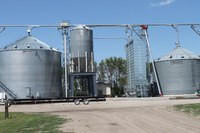NDSU offers advice on harvesting and drying sunflower in North Dakota
(Click the image below to view a high-resolution image that can be downloaded)
According to U.S. Department of Agriculture’s National Agricultural Statistics Service, as of Sept. 25, 35% of the sunflower had brown bracts indicating maturity, behind the 50% average. The near-term forecast is for continued warm temperatures, so most sunflower should reach or be near maturity, according to Ken Hellevang, North Dakota State University agricultural engineer and grain drying expert.
“There is considerable variation this year due to the challenging spring, variation in rainfall, planting date, maturity rating and growing degree days, so it is important to check each field,” Hellevang says.
The current forecast for October is slightly above normal temperatures and normal precipitation. October showers can have a major impact on crops drying in the field. The amount of drying in the field depends on parameters such as maturity, hybrid, moisture content, air temperature, relative humidity, solar radiation and wind speed.
A predictor of the drying rate is potential evapotranspiration (PET-Penman), which is based on parameters similar to those that affect drying. Values for PET are available on the North Dakota Agricultural Weather Network website. Go to “Weather Data” and select the location and time period and it will provide the estimated evaporation during that time period. One inch of evaporation is equivalent to about 4 percentage points in corn. Unfortunately, the correlation has not been developed for sunflower, but the relative amount can be estimated.
Field drying normally is more economical until mid to late October in North Dakota and mechanical high-temperature drying normally is more economical after that, Hellevang notes.
The amount of natural air drying in bins that will occur in northern states in late October and early November is limited, since the moisture-holding capacity of air is reduced at lower air temperatures, Hellevang says. As average air temperatures drop below 40 degrees Fahrenheit, natural air drying becomes less efficient and economical. Adding heat causes the grain on the bottom of the bin to dry to a lower moisture content and increases drying speed only slightly. Sunflower at 15% moisture can be dried some during late October and early November by heating the air about 5 degrees and using an airflow rate of 1.0 cubic feet per minute per bushel.
Hellevang recommends cooling the sunflower to between 20 and 30 degrees for winter storage and completing the natural air drying in the spring. Start drying in the spring when outdoor temperatures are averaging about 40 degrees.
Sunflower can be dried in a high-temperature dryer, but dryer fires are a concern. The fire hazard is not related to drying temperature, but rather to housekeeping and managing the dryer. Hellevang has this advice to reduce the risk of fires:
- Assure that trash does not accumulate in the dryer or on the dryer.
- Assure that the sunflower continues to flow in all sections of the dryer.
- Monitor the dryer continuously.
- Clean the dryer frequently to reduce the potential for debris to combust.
If a fire occurs, shut off the fan, extinguish the fire and empty the dryer section with the fire.
Oil sunflower should be dried to about 10% moisture for storage over winter and about 7% to 8% if being stored into next summer. Non-oil sunflower can be stored at about 10% moisture during the summer. Cool the sunflower to 20-25 degrees for winter storage. Hellevang supports using temperature cables to assist with monitoring the sunflower, but technology does not replace management. He still recommends monitoring the sunflower moisture content, inspecting for insects and observing the sunflower quality.
Remember safety when working around grain. Protect yourself from grain dust with an N95 mask. Do not go into a grain bin while the grain is moving. It only takes a couple seconds to become helpless in flowing grain. Use the lock-out tag-out system to assure that you do not get hurt while working on grain drying and handling equipment.
For more information on high-moisture sunflower drying and storage, search online for NDSU grain drying and storage.
NDSU Agriculture Communication – Sept. 30, 2022
Source: Ken Hellevang, 701-231-7243, kenneth.hellevang@ndsu.edu
Editor: Elizabeth Cronin, 701-231-5391, elizabeth.cronin@ndsu.edu


